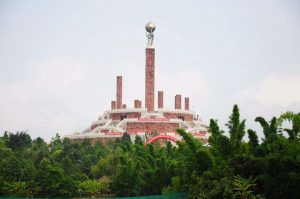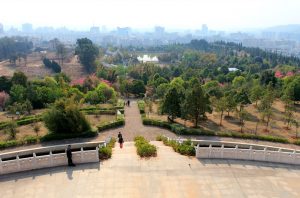Ten-Month Solar Calendar Park in Chuxiong
Chinese Name:楚雄太阳历公园
English Name: Ten-Month Solar Calendar Park, Chuxiong
Chuxiong is a fascinating land fostering an age-old minority with brilliant culture, among which the Ten-month Solar Calendar is the most striking one. According to this calendar, one year was divided into ten months in five seasons. There were 36 days in a month and two months constituted a season. So, the total was 360 days. The rest 5 or 6 days were defined as annual festival.
It shows that the revolution time of the earth rounding the Sun was 365.25 days, It’s the most precise ancient calendar then and in the long years to come. It is not only a treasure with great scientific and humanistic value in Yi’s culture, but the intellectual crystallization of Chinese people, the cultural heritage of the whole world.
The Ten-month Solar Calendar Park, constructed with the aim to show the quintessence of the world civilization, is a place combining the study of ethnic culture, the demonstration of folk custom, the exhibition of local art, and the trade and entertainment together. It is undoutfully an unique assembly of the marrow of the Yi heritage and a dynamic museum of the Yi culture.

Situated in the suburb of Chuxiong city, The Ten-month Solar Calendar Park covers an area of more than 500 mu. With its own feature and the beautiful landscape of Chuxiong around, it is absolutely a great place for tourists.
Bishan Tiger is found under the roof of almost every house in the residence neighborhood of Yi ethnic groups. Some of them are made from stone, some from mud, and some from wood. Whenever a new house is built, the owner will choose a lucky time, asking people to recite or chant scriptures, praying to Buddha while the Bishan Tiger is put under the roof. It is believed such a tiger may protect those who live under the roof from all the devils and bad luck. Goddess of gourd£º This was the worship of maternal procreation in the early Yi era.
It is also an important part in the totem of the Yi ethnic groups. Dancing of the Yi people£º This scene shows how Yi people of different areas and ties dance when the festivals come, including the left foot dance and three stamping dance in the Chuxiong area, the female moon dance and the cigarette case dance in Honghe area, the carrying of bride, fighting of bulls, wrestling, the dance of March, the dance of dress competition and so on. The Ten-month Solar Calendar Square This is a round square covering 5220.4 square meters with three stages.
The low stage is 72 meters in diameter and 8.4 meters in height; the middle stage is 54 meters in diameter and 5.7 meters high. The upper stage is 36 meters in diameter and 4.2 meters high. All together there are about 40 embossments on the surface of the stages, telling the major folk stories abut the Yi people. The embossments inscribes 7275 people of different characters and 1858 animals of different shapes, which boasts to be one of the greatest embossment groups in China.

Memorial Altar
The ten-month calendar is based on the observation of the move of the sun and the position of the Big Dipper, which is scientific, simple and easy to understand. This altar tells exactly how the ten-month solar calendar works. Ten animals for ten months In the ten-month calendar there are ten animals which are used to symbolize the ten months in a year. It begins with black tiger of January, followed by otter of February, crocodile of March, python of April, pangolin of May, muntjac of June, rock sheep of July, monkey of August, panther of September, and lizard of October. Because of this reason, the ten-month calendar is also called the ten animal’s calendar.
Travel Tips
The calendar is created by the Yi people almost 5000 year ago. According to this calendar, one year was divided into ten months in five seasons. There were 36 days in a month and two months constituted a season. So, the total was 360 days. The rest 5 or 6 days were defined as annual festival. It shows that the revolution time of the earth rounding the Sun was 365.25 days; it’s the most precise ancient calendar then and in the long years to come.

 7 Days GolfingTour
7 Days GolfingTour
 8 Days Group Tour
8 Days Group Tour
 8 Days Yunnan Tour
8 Days Yunnan Tour
 7 Days Shangri La Hiking
7 Days Shangri La Hiking
 11 Days Yunnan Tour
11 Days Yunnan Tour
 6 Days Yuanyang Terraces
6 Days Yuanyang Terraces
 11 Days Yunnan Tour
11 Days Yunnan Tour
 8 Days South Yunnan
8 Days South Yunnan
 7 Days Tea Tour
7 Days Tea Tour
 8 Days Muslim Tour
8 Days Muslim Tour
 12 Days Self-Driving
12 Days Self-Driving
 4 Days Haba Climbing
4 Days Haba Climbing
 Tiger Leaping Gorge
Tiger Leaping Gorge
 Stone Forest
Stone Forest
 Yunnan-Tibet
Yunnan-Tibet
 Hani Rice Terraces
Hani Rice Terraces
 Kunming
Kunming
 Lijiang
Lijiang
 Shangri-la
Shangri-la
 Dali
Dali
 XishuangBanna
XishuangBanna
 Honghe
Honghe
 Kunming
Kunming
 Lijiang
Lijiang
 Shangri-la
Shangri-la
 Yuanyang Rice Terraces
Yuanyang Rice Terraces
 Nujiang
Nujiang
 XishuangBanna
XishuangBanna
 Spring City Golf
Spring City Golf
 Snow Mountain Golf
Snow Mountain Golf
 Stone Mountain Golf
Stone Mountain Golf















